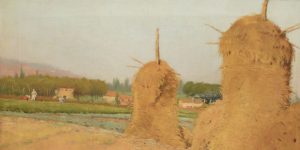Biografia
Rusiñol stands as one of the foremost painters of late 19th and early 20th-century Spain, firmly entrenched among the preeminent figures of pictorial Modernism. Born into a bourgeois family with ties to the textile industry, he diverged from familial expectations at a tender age to pursue his passion for painting and drawing under the tutelage of Tomàs Moragas (1837–1906) at the esteemed Barcelona workshop. From his youth, Rusiñol displayed a profound affinity for landscapes, particularly influenced by the works of Joaquim Vayreda (1843–1894), who introduced impressionist techniques to the Barcelona art scene.
Rusiñol's insatiable wanderlust transformed into his modus vivendi, as he traversed landscapes, perpetually uncovering new pictorial motifs, colours, and sensations, all of which he adeptly captured in his art. His quest for independence reached its zenith in 1889, as he embarked on sojourns to Paris alongside fellow artist friends, including Ramon Casas (1866-1932). Paris, the epicentre of modernity and Impressionism, became Rusiñol's muse, with Bohemian ideals serving as his guiding ethos. He found inspiration in the works of luminaries such as Henri de Toulouse-Lautrec, Paul Signac, James Whistler, and Théophile Steinlen, fostering close relationships with pivotal figures of the late 19th-century French art scene, including the renowned musician Erik Satie (1866 -1925). This period marked Rusiñol's apotheosis as a painter, garnering accolades and acclaim in Paris, Barcelona, and Madrid alike. He immortalized the Bohemian scenes he encountered at the Moulin de la Galette and in Montmartre, deftly capturing the melancholy, destitution, and ethereal allure of the Ville Lumière. His artistic prowess earned him medals and accolades at prestigious painting events, solidifying his status as a luminary of his time.
In Barcelona, venues such as the Sala Parés and the modernist enclave Els Quatre Gats served as epicentres for the dissemination of Rusiñol's literary and pictorial oeuvre. However, it was during a transformative journey to Granada in 1895 that he stumbled upon his defining artistic motif: the abandoned gardens. Departing from the verdant landscapes of the Alhambra and the Generalife, Rusiñol embarked on a relentless exploration of Spain, where decrepit gardens stood as perennial protagonists. Infused with a profound sense of melancholy, solitude, and wanderlust, Rusiñol's exploration of this theme propelled him to newfound triumphs in both national and international artistic arenas. Rusiñol's art, revered by aristocrats and bourgeoisie alike, epitomized the zenith of Spanish artistic production. Beyond his prowess as a painter, Rusiñol distinguished himself as a luminary in literature, philosophy, and aesthetics, wielding profound influence over literati and artists across France and Spain.


